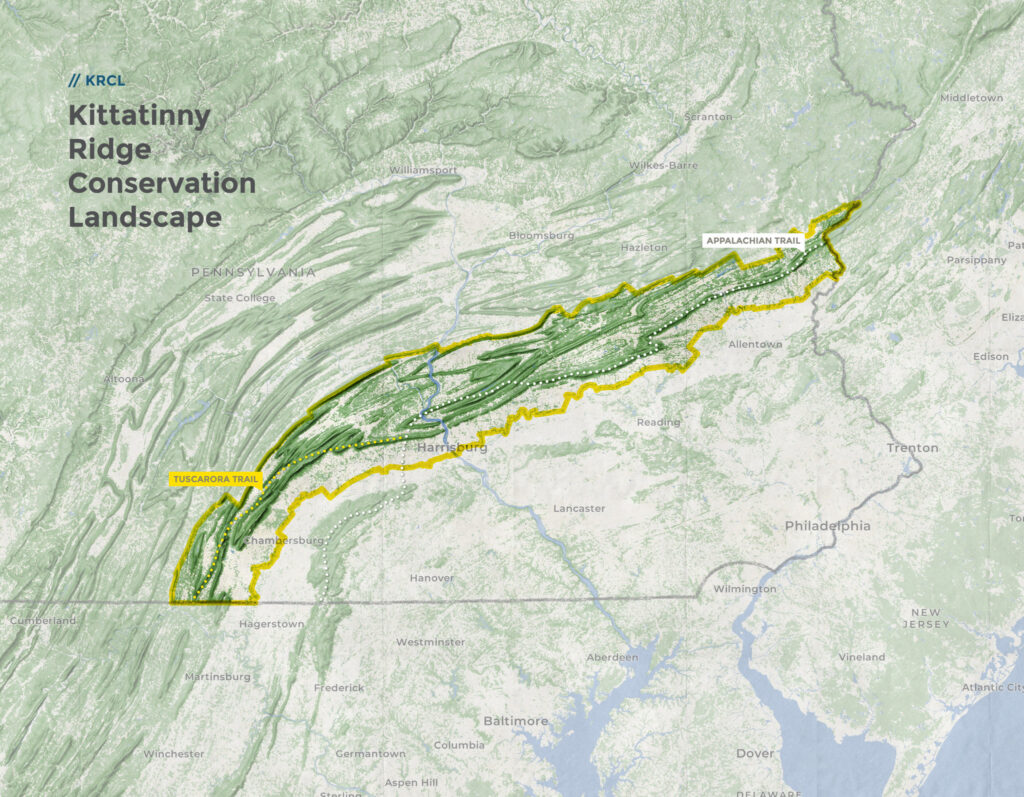By Rose McCarthy, Special Projects Liaison,
Pennsylvania Governor’s Office of Policy and Planning
Shared by USDA NRCS on December 11, 2024
Located in eastern Pennsylvania’s Appalachian Mountains, the Kittatinny Ridge, also known as the Ridge, stretches over185 miles along the historic Appalachian Trail. Serving as a vital wildlife corridor, the Ridge supports a diverse range of species, from migratory birds to butterflies, and plays a key role in maintaining biodiversity and ecological balance in the region. Its forested ridges and fertile valleys are essential for supplying clean water, sequestering carbon, and contributing to Pennsylvania’s working lands and outdoor recreational economies.
The Kittatinny Ridge Sentinel Landscape (KRSL) brings together stakeholders from different sectors to protect the Ridge’s military assets, preserve ecological integrity and climate resiliency, and support local economies. According to data from The Nature Conservancy, the Ridge’s connected forests make it one of the most climate resilient landscapes in the nation. These forests help buffer the impacts of climate change by storing carbon, reducing temperatures, supplying clean drinking water, and absorbing stormwater to mitigate flooding. The Ridge’s designation as a sentinel landscape supports the conservation of high-quality freshwater resources that contribute huge volumes to local rivers and the Chesapeake Bay, providing areas for wildlife to migrate along the Ridge and find refuge from the changing climate. These climate adaptation benefits extend to Ridge installations, reducing training time lost due to extreme weather.
The Ridge provides continuous habitat for migratory birds, with thousands of raptors, songbirds, and other avian species traversing its expanse each year. It is recognized as the premier northeast raptor migratory route, supporting six monitoring sites, including at Hawk Mountain Sanctuary, renowned for birdwatching and research. In 2015, the National Audubon Society designated the Ridge as a Globally Important Bird Area for its role as a migratory corridor and breeding site for declining forest birds, such as cerulean warblers (Setophaga cerulea).
The Ridge is an important breeding area for a declining migratory forest bird, the cerulean warbler.
The Ridge is a critical preserve for hundreds of wildlife species. The Eastern Regal Fritillary Butterfly Program at FTIG (Fort Indiantown Gap) is a shining example of successful wildlife management. This butterfly species (Argynnis idalia idalia) has seen dramatic population decline due to habitat loss and other environmental pressures. However, FTIG has become a sanctuary for this rare species as it hosts the only known population of this butterfly in North America. The perseverance of the eastern regal fritillary butterfly (regal) at FTIG is no coincidence. Military training activities at FTIG, the busiest National Guard training center in the nation (2023), create disturbances that maintain rare early successional grassland habitat, which is essential for the regal’s survival.
In the mid-1990s, FTIG biologists began implementing strategies to monitor and expand the regal population. The captive rearing program, launched with Zoo American in 2011, aims to breed and reintroduce the butterflies into suitable habitats, increasing chances of survival and recovery. With the U.S. Fish and Wildlife Service recently proposing to list the regal as an endangered species, these conservation efforts are expected to intensify, offering greater protection for this species.
A female eastern regal fritillary butterfly at Fort Indiantown Gap. Source: PA DMVA/PAARNG
In 2017, Letterkenny Army Depot (LEAD), a major explosives storage facility along the Ridge, partnered with the Pennsylvania Game Commission (PGC) to create a Bobwhite Quail Focus Area at LEAD. In 2014, the PGC deemed bobwhite quail (Colinus virginianus) extirpated in Pennsylvania. Extensive habitat management efforts began in 2017, and in March 2024, the PGC worked with other states to translocate 87 wild bobwhites to LEAD. In July 2024, the first wild Pennsylvania bobwhites were born at LEAD.
Bobwhite Quail, PennState Extension
While the efforts at FTIG and LEAD have been successful, the Ridge faces ongoing conservation challenges, including incompatible development, climate change, and habitat fragmentation. With only 20 percent of the Ridge currently protected, a myriad of partners have come together to expand efforts. The successes at FTIG and LEAD highlight the unique and unexpected synergy between active military operations and calculated conservation activities and demonstrate the potential for innovative strategic action in the landscape.
Pennsylvania is a leader in farmland preservation through permanent agricultural conservation easements, which protect corridor lands from development. The Pennsylvania Department of Agriculture, with the U.S. Department of Agriculture Natural Resources Conservation Service (NRCS) and a coalition of other entities, leverages funds toward land preservation investments throughout the Ridge. From 1996 to present, the NRCS funding has protected nearly 55,000 acres through 483 easements in the priority area. KRSL designation ensures further protection.
KRSL partners will continue working together to enhance habitat connectivity and climate resiliency to ensure that one of the most biodiverse regions in eastern North America remains a haven for species and a source of inspiration for all who cherish the natural world.
Related posts
Kittatinny Ridge Conservation Landscape
The Chesapeake Watershed Celebrates Its Third Sentinel Landscape:
Kittatinny Ridge
by Jamal Childs
Does the Cerulean Warbler Have the Blues?
Improving Cerulean Warbler Habitat
Posted on July 06, 2021 in On the Mountain by Sean Grace, President
A Bird Migration Corridor like No Other,
the Kittatinny Ridge Depends on a Healthy Forest
Posted by Audubon Pennsylvania
Saving A Butterfly: A “Regal” Recovery at FTIG
Posted on April 20, 2023 by Fort Indiantown Gap
LEAD environmental division postures installation
for northern bobwhite quail reintroduction
Posted on March 20, 2024 by Joshua Shinn on DVIDS Hub
Northern Bobwhite Quail Management Plan for Pennsylvania 2021-2030
Published on February 17, 2021 | Prepared By: Thomas J. Keller
Pennsylvania Game Commission
Kittatinny Ridge CL Awarded $9.9 Million
through the United States Department of Agriculture (USDA)
Natural Resources Conservation Service’s (NRCS)
Regional Conservation Partnership Program (RCPP)
Posted on April 30, 2020 by Kittatinny Ridge
